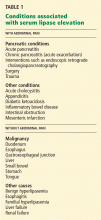When should serum amylase and lipase levels be repeated in a patient with acute pancreatitis?
In general, repeating serum amylase and lipase levels has no value once the diagnosis of acute pancreatitis has been made. In gallstone-related acute pancreatitis (ie, in most cases), delaying surgery for several days for the pancreas to “cool down” is common practice, but repeating serum pancreatic enzyme levels daily during this period is of no prognostic value, as the levels do not correlate with the severity, course, or outcome of the acute pancreatitis.1–3 Rather, the decision to proceed with treatment should be based on clinical measures, such as improvement of pain or increasing appetite.
Repeated pancreatic enzyme tests have diagnostic value, though. For example, in mild acute pancreatitis, symptoms tend to resolve in less than 1 week, whereas in severe cases, not only do symptoms persist beyond 1 week, but complications (new symptoms) also develop after the first week. In such cases, serum amylase and lipase levels may be repeated when the patient has signs and symptoms of persisting pancreatic or peripancreatic inflammation, blockage of the pancreatic duct, or development of a pseudocyst, 3 but the purpose of retesting the levels is to diagnose complications, not to monitor the status of the pancreas. However, imaging tests generally have a higher sensitivity than serum amylase and lipase levels for diagnosing complications of acute pancreatitis.
MAKING BEST USE OF SERUM PANCREATIC ENZYME LEVELS
,Amylase is also noted in salivary glands, fallopian tubes and cyst fluid, testes, lungs, thyroid, tonsils, breast milk, sweat, tears, and some malignant neoplasms. Serum lipase is often considered a more specific marker of acute pancreatitis than serum amylase, but recent data cast doubt on this.5






